From voyages of trade and discovery to colonisation:
This section of the grade 10 curriculum was developed in 2009. While much of the content is still relevant to the new curriculum, the focus is slightly different. However, it provides for great further reading. In this section you will look at how the expansion of European trade led to the establishment of fortified trading stations and eventually permanent European settlements in the Americas, Africa and India.
Early European voyages of trade and discovery
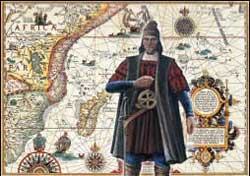 Bartholomeu Dias, the first European to sail around the southern tip of Africa. Picture: SAHO collage
Bartholomeu Dias, the first European to sail around the southern tip of Africa. Picture: SAHO collage
The powerful Ottoman Empire blocked European access to markets in the East. The Ottoman Turks controlled trade routes to the East.
The main reason why Europeans began to search for a sea route to the East was to avoid paying expensive customs duties, or taxes. The rulers of every country between India and Europe charged a tax on the spice shipments as the goods passed through their land. Europeans used spices such as salt, nutmeg and cloves to preserve their meat, as they did not have refrigerators to keep meat fresh.
During the fifteenth century the Portuguese began to explore the west coast of Africa. They established trading stations and began trading in gold and slaves in competition with the inland trans-Saharan trade routes.
Diogo Cão reached the mouth of the Congo River in 1483 and Cape Cross in 1486. Bartholomeu Dias was the first European to sail around the southern tip of Africa. He reached Mossel Bay in 1488 and on his way back to Portugal saw the Cape peninsular for the first time and named it the ‘Cape of Storms’ because of the bad weather the ships experienced there.
King John II of Portugal was so pleased when he heard the news that he renamed it the ‘Cape of Good Hope’. In late 1497, the Portuguese navigator Vasco da Gama sailed around the Cape of Good Hope using Dias’s navigational charts. He stopped at several places along the east coast of Africa. At the port of Malindi, he found an experienced Arab navigator, Ibn Majid, who joined the expedition and showed him the sea route to India across the Indian Ocean. They arrived in Calicut in 1498.
While the Portuguese were looking for a route to India around Africa, the Spanish were looking for a western route. Sponsored by King Ferdinand and Queen Isabella of Spain, the Italian navigator, Christopher Columbus, sailed west across the Atlantic in an effort to reach Asia in 1492.
Columbus based his voyage on his calculation of the earth’s size (which later turned out to be wrong). He reached the Caribbean islands off what would later be called North and South America. He was convinced he had found the East Indies. Columbus claimed San Salvador, Cuba and Hispaniola for the Spanish crown where he established trading stations to finance his voyages.
The attempts by Columbus and da Gama to find new trade routes to the East encouraged exploration in other areas. King Henry VII of England sponsored John Cabot’s exploration of a north-western route to the East. In 1497 he discovered Newfoundland and Nova Scotia. At the same time Amerigo Vespucci claimed to have discovered a ‘New World’ in 1497 when he landed on the continent of South America. These discoveries resulted in European colonisation during the sixteenth and seventeenth centuries.
The role of companies
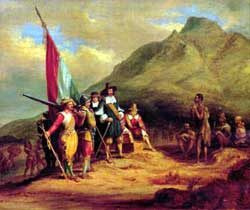 Jan Van Riebeeck and his crew, holding the Dutch East India Company flag, arrive at the Cape of Good Hope and meet the Khoikhoi. Picture source: Cape Town Archives.
Jan Van Riebeeck and his crew, holding the Dutch East India Company flag, arrive at the Cape of Good Hope and meet the Khoikhoi. Picture source: Cape Town Archives.
A number of companies were formed in Europe during the seventeenth and eighteenth centuries to further expand trade with the East. These were formed by merchant adventurers who travelled to the East after the discovery of the Cape sea route. These companies were given charters to trade by the governments of their countries. This meant that the rulers of Europe were not directly involved in trade. They did, however, support the companies and welcomed the increased wealth that trade brought to the economy.
A charter is a document giving authority to companies to take over and control other areas. This control included various functions of government such as making laws, issuing currency, negotiating treaties, waging war and administering justice. These were the most important of these chartered companies:
- Danish East India Company;
- English East India Company;
- French East India Company.
Colonisation
Colonisation is the process of acquiring colonies. European powers took over land by force and then settled European people on the land. The conquered land then became known as a colony. Imperialism is a policy of extending a country’s power and influence through colonisation, use of military force, or other means.
Over the past 500 years there have been different phases of colonisation.
Trading Stations
In the early stages of colonisation, colonies were mainly trading stations. At first, Portugal and Holland were more interested in trade than settling people in colonies. They built forts along the coastline of Africa and Asia to protect their trade and did not try to control land in the interior. As the colonial trade became more competitive, trading stations grew into colonies of settlement.
Colonies of settlement
During the phase of colonial settlement, European countries sent settlers to inhabit and control large areas of land. They took complete control of new areas by force and imposed European laws. These settlers often excluded indigenous inhabitants from their society or killed many of them in violent wars or through disease. In the Americas, many Native Americans died from diseases that were brought to their land by Europeans. Examples of settlement colonies include English colonies in parts of the United States, Canada and Australia.
Colonies of exploitation
Colonies of exploitation did not attract large numbers of permanent European settlers. Small numbers of Europeans went to these colonies mainly to seek employment as planters, administrators, merchants or military officers. In exploitation colonies, the colonisers used force to crush resistance and maintain control. They did not displace or kill indigenous societies; instead they made use of their labour. Colonies of exploitation included Indonesia and Malaya in South-East Asia, and Nigeria and Ghana in West Africa.
Contested settlement colonies
In a contested settlement colony, a large number of Europeans permanently settled in the colony. In America, settlers started their own government and cut ties with their country of origin. In some cases the indigenous population not only resisted but increased in size and their labour remained the backbone of the economy, as was the case in South Africa. However, when the United States of America broke away from Britain, the indigenous population was virtually wiped out and slave labour had to be imported to do the work.
Informal empires
In informal empires, Europeans had influence over the rulers of the country without taking control of it. During the nineteenth century, individual Western nations called parts of China their sphere or area of influence. These Western nations even required that disagreements involving Europeans in these areas be judged according to Western laws in Western courts.
Reasons for colonisation
A quick way to remember the main reasons for establishing colonies is ‘gold, God and glory’, but you need to understand each reason in more detail.
Economic reasons
Colonies were important sources of raw materials (such as raw cotton) and markets for manufactured goods (such as textiles). The colonising country could prevent competitors from trading with its colonies. This is known as a trade monopoly. The exploitation of mineral and other resources provided great wealth for the colonising country. Gold, in particular, was a highly sought-after commodity. Individual investors saw opportunities to make personal fortunes by helping to finance the establishment of colonies. Both slavery and colonisation provided cheap labour which increased profits and added to the wealth of the colonisers.
Humanitarian reasons
Europeans believed that it was their duty to spread Christianity among ‘heathens’ (non-believers) in other countries of the world. Both Roman Catholic and Protestant missionaries were sent to remote areas in order to convert people to Christianity. Missionaries also offered the indigenous people Western education and medical care, which they believed were better than those offered by traditional teachers and healers. They believed they were doing God’s work and helping to ‘civilise’ the rest of the world. They were known as humanitarians because they were concerned about the welfare of their fellow human beings. Unfortunately, many greedy and ruthless people hid behind religion to disguise what they were actually doing – destroying whole cultures and civilisations so that they could have control over the people and their land.
Prestige
Countries with large empires were respected and admired. Increased wealth resulted in greater military and political power. A small country like England became one of the most powerful empires in the world by taking over large areas of land and dominating international trade. Competition and rivalry among the colonial powers often resulted in war, as they tried to take over each other’s colonies.
Strategic reasons
Certain colonies were acquired for their strategic importance. This means that they were well positioned in times of war. They also enabled the colonisers to control trade routes. The settlement at the Cape is a good example of a strategic reason for acquiring a colony. As long as the Dutch controlled the Cape, they controlled the sea route to the East. The Dutch built a fort on the Cape peninsula to defend the colony against attack from rival colonial powers.
Conquest, warfare and early colonialism in the Americas
The Caribbean Islands
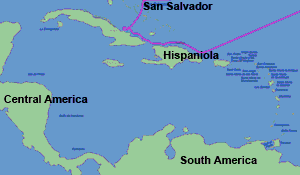 Columus’ First Voyage to San Salvador, Cuba and Hispaniola. Source: wikipedia
Columus’ First Voyage to San Salvador, Cuba and Hispaniola. Source: wikipedia
On his first voyage, Columbus claimed San Salvador, Cuba and Hispaniola as Spanish possessions. He built a fort and left behind Spanish soldiers to hunt for gold on Hispaniola, while he returned to Spain (These men were later murdered by the inhabitants of the island for mistreating them).
On his second voyage, Columbus took a thousand Spanish colonists to settle in Hispaniola. This was the first European colony in the ‘New World’. These colonists fought among themselves and with the inhabitants of the island. They were greedy and complained that there was not enough gold to make them all rich. They were given land and allowed to force the indigenous people to work for them, but they were still not satisfied. The colonists were also responsible forintroducing foreign epidemic diseases such as influenza, smallpox, measles and typhus, which drastically reduced the indigenous population in the Caribbean within 50 years.
The American mainland
In the early 1500s the Spanish began to conquer the mainland of Central and South America. Vasco NÁºÁ±ez de Balboa, a Spanish merchant, was considered the first of the conquistadors. Balboa is best known as the first European to see the Pacific Ocean. However, his expedition did not end well as one of his rivals, the newly appointed governor of Darien (Panama) had him executed. Today, Panama honours Balboa by naming its monetary unit, the balboa, after him.
Conquering the Aztec Empire
You learnt about the wealthy and powerful Aztec Empire in the previous section. The following case studies will tell you more about how this mighty empire was destroyed by the Spanish.
Conquest Case Study 1
In 1519 the Spanish conquistador, Herman Cortés, led an expedition into central Mexico in search of land and gold. He arrived with five hundred men wearing armour. They brought with them cannons, mastiff dogs and sixteen horses. Cortés defeated the enemies of the Aztecs, the Tlaxcalans, and then formed an alliance with them in order to defeat the Aztecs. Thousands of Tlaxcalans who wanted to see the destruction of the Aztec Empire joined him as he rode to Tenochtitlán, the capital city.
The Aztec ruler, Emperor Montezuma II, greeted Cortés with gifts because he believed that he was the Aztec god, Quetzalcoatl, who had come from the sea. He allowed Cortés to enter the city in order to learn more about the Spaniards and their intentions. When the Spaniards saw large amounts of gold and other treasures, they captured the emperor and began to rule the empire. With the assistance of the Tlaxcalans, and after many bloody battles, the Spaniards eventually defeated the Aztecs in August 1521. The Spaniards conquered the remaining Aztecs and took over their lands, forcing them to work in gold mines and on Spanish estates.
The fall of Tenochtitlán marked the end of the Aztec civilisation, which had existed for centuries. The city was looted of all its treasures and then the buildings were blown up with barrels of gunpowder. On the ruins of Tenochtitlán, the Spaniards built Mexico City. The city’s present-day cathedral rises over the ruins of an Aztec temple and the palace of the Mexican president stands on the site of the palace of Montezuma. The Spanish called their new colony in Mexico ‘New Spain’.
Conquering the Inca Empire
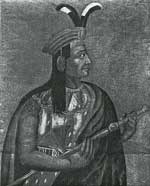 This is a portrait of Atahualpa, drawn from life, by a member of Pizarro’s detachment, 1533. Source: wikipedia
This is a portrait of Atahualpa, drawn from life, by a member of Pizarro’s detachment, 1533. Source: wikipedia
Conquest Case Study 2
Francisco Pizarro was the Spanish conqueror of Peru. He left Spain for the West Indies in 1502 and lived on the island of Hispaniola. He was also part of Balboa’s expedition to the Pacific Ocean. Pizarro heard tales of a southern land rich in gold. During the 1520s Pizarro led two expeditions down the west coast of South America and saw the golden ornaments worn by Native Americans of the Inca Empire of Peru. He got permission from the emperor of the King of Spain, Charles V to conquer this land and become its governor. Pizarro raised an army of 180 men to take with him to Peru. Atahualpa, the Inca, or emperor, was captured by the Spaniards, who held him hostage. His followers were tricked into paying a large ransom of silver and gold. Instead of sparing his life as promised, Pizarro executed Atahualpa on 29 August 1533 and took control of the town of Cajarmaca.
Pizarro then marched south and captured the Inca capital at Cuzco. After looting Cuzco, the Spaniards went on to establish control over the rest of the land of the Incas. Without an emperor to lead them, the Incas found it hard to resist the Spanish invasion. They were divided among themselves and their weapons were no match for the guns of the Spaniards. Only one Inca community, which was high up in the mountains and difficult to reach, held out against the conquistadors. It survived as the last Inca stronghold until the Spanish conquered it in 1572 and executed its ruler, Tupac AmarÁº.
In 1535, Pizarro set up a new capital at Lima and, as governor, was responsible for bringing many settlers to Peru. Most settlers were involved in mining the vast amounts of silver and gold that existed in Peru. The Spanish were allowed to force the Incas to work for them for low wages. They used forced labour in the army, to build new cities and to mine silver and gold.
You have already heard that conquistadors often fought among themselves. Diego de Almagro, Pizarro’s former partner, fought with Pizarro over Cuzco. The power struggle between Pizarro and Almagro led to the War of Las Salinas in 1538. Almagro was executed, but his son, known as Almagro the Lad, continued the war. Pizarro was murdered in his palace in Lima by followers of Almagro in 1541.
Resistance to Spanish colonialism
The Aztec and Inca Empires covered very large areas and consisted of millions of people. It was only after long and bloodied battles that they gave up their capitals to the invaders. The European diseases that reduced the population of the indigenous people of the Caribbean islands also affected the Aztecs, and to a lesser degree the Incas.
The Spanish were less successful against the people who occupied other areas of Central and South America. These people attacked unexpectedly and took advantage of the fact that they outnumbered the Spanish. In 1542 the Spanish founded the city of Mérida in the north-western corner of Mexico, but they controlled only some of the areas around this city. The biggest part of the peninsula was still ruled by Mayan communities.
Resistance Case Study 3
The Spanish encountered particularly fierce resistance from the Auracanian tribes. After the conquest of the Inca Empire, a Spanish force moved southward to found the city of Santiago in 1541. They gained control over the fertile central region of present-day Chile. The Araucanians lived in the southern part of Chile, and resisted Spanish control until well into the nineteenth century. The Spanish built a line of forts to defend their settlements against continuous Araucanian attacks and raids. The Araucanians adapted to the European style of warfare by making spears to fight the Spanish while they were on their horses. The Araucanians were finally defeated at the end of the 1870s and forced to live in reservations.
Resistance Case Study 4
A distinct type of resistance in exploitation colonies was the slave revolt. The most dramatically successful was the Haitian Slave Revolt, on the Caribbean island of Hispaniola, led by Francois Dominique Toussaint Louverture. The revolt, lasted from the early 1790s until 1804, when Haiti received its independence. There were many other slave revolts throughout the Caribbean and Brazil. Some of these revolts failed and many slaves who had participated in revolts were brutally tortured and executed.
The legacy of the Spanish in Central and South America
- Disease and forced labour drastically reduced the population of Central America. It is estimated that the population of Mexico was reduced by ninety per cent in the first fifty years after the arrival of the Spanish.
- In Central and South America, the Spanish settlers eventually intermarried with the Incas and Aztecs as most of the settlers were men. The people of mixed racial descent are known as mestizo and now form the majority of the population.
- The official language of the former Spanish colonies in the Americas is Spanish but there are many people who still speak their indigenous languages.
- The indigenous people were also converted to Catholicism which remains the dominant religion in Central and South America.
Colonialism in Africa
Early colonialism in Africa, Portuguese trading stations in West Africa
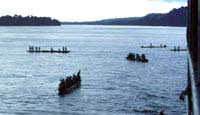 The Congo River. Source: dlynnwaldron.com
The Congo River. Source: dlynnwaldron.com
Portuguese expansion into Africa began with the desire of King John I to gain access to the gold-producing areas of West Africa. The trans-Saharan trade routes between Songhay and the North African traders provided Europe with gold coins used to trade spices, silks and other luxuries from India. At the time there was a shortage of gold and rumours were spreading that there were states in the south of Africa which had gold. This news encouraged King John’s son, Prince Henry, to send out expeditions to explore these possibilities.
At first, the Portuguese established trading stations along the west coast of Africa rather than permanent settlements. They built forts at Cape Blanco, Sierra Leone and Elmina to protect their trading stations from rival European traders. In this way, the Portuguese diverted the trade in gold and slaves away from the trans-Saharan routes causing their decline and increased their own status as a powerful trading nation.
During the 1480s the Portuguese came into contact with the kingdom of the Kongo, situated south of the Congo river in what is today northern Angola. The Kongo became powerful through war and capturing and enslaving the people they defeated.
The Portuguese did not conquer this region but chose rather to become allies of the Kongo king. The king was eager to make use of Portuguese teachers and craftsmen to train his people. He also allowed Catholic missionaries to work among his people. The Portuguese traded guns for slaves captured by the Kongo in wars against rival kingdoms in the interior. Other than small amounts of copper and raffia cloth, the area did not provide any profitable trade in gold or silver, which was disappointing for the Portuguese. The traffic in slaves more than made up for this disappointment.
In the 1490s sugar plantations were established on the islands of São Tomé and Principé. The Portuguese settlers on these islands used slaves bought from the Kongo traders to work on these plantations. Very soon São Tomé became the largest producer of sugar for Europe. When Brazil became a Portuguese colony in the 1530s, the demand for slaves to work on the sugar plantations established there increased. São Tomé became an important holding station for slaves before they left on the trans-Atlantic voyage to South America.
As the demand for slaves increased in Brazil, the São Tomé traders found a better supply of slaves further south near Luanda and Benguela. Wars fought in this region provided a constant supply of slaves. In exchange for slaves, the Portuguese provided the Ndongo and Lunda kings with guns, cloth and other European luxuries. The guns enabled the kings to defeat their enemies and maintain a dominant position in the region.
In 1641, the Dutch seized the slave trade in Angola away from the Portuguese and they were able to control it until 1648 when the Portuguese took back control again. Angola only became a Portuguese colonial settlement after the decline of the slave trade in the nineteenth century.
The legacy of the Portuguese in western-central Africa
- The Portuguese introduced agricultural products grown in South America such as maize, sugar cane and tobacco. Coffee plantations were introduced to Angola in the nineteenth century. Coffee is one of Angola’s major exports today.
- The Portuguese introduced guns to the region which changed the nature of warfare and enabled their allies to dominate other kingdoms.
- The Portuguese encouraged wars between rival kingdoms to maintain a constant supply of slaves. The result of this was that the region was constantly at war and millions of young people, mainly men, were forced to leave Africa and work as slaves in the Americas.
- The Portuguese language is mainly spoken in urban areas of Angola today. However, the indigenous languages have survived among the rural population.
- In modern Angola, about ninety per cent of the population is Christian, mainly Catholic, as a result of Portuguese missionary activity in the area. The remainder of the population follows traditional African religions.
Portuguese trading stations in East Africa
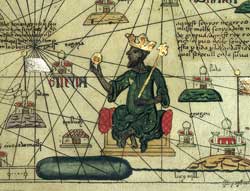 A map drawn in Spain dated 1375, showing the king of Mali holding a gold nugget. Source: British Library
A map drawn in Spain dated 1375, showing the king of Mali holding a gold nugget. Source: British Library
Well-established gold and ivory trade network existed between African kingdoms in the interior and cities on the east coast of Africa. For centuries Arabs had traded with African kingdoms such as Great Zimbabwe and Mwanamutapa in order to supply Arabia, the Persian Gulf, India and even China with African ivory and gold. The Arab settlers intermarried with the indigenous African people living along the east coast. They introduced Islam and influenced the development of the Swahili language. A new coastal society emerged that was a mixture of African and Islamic traditions. This prosperous society built beautiful cities along the coastline from where they conducted trade with Arab merchants. The most important of these cities were Zanzibar, Kilwa, Mombasa, Mozambique Island and Sofala.
In the sixteenth century the Portuguese drove the Arabs away from the east coast of Africa and established their own trade monopoly in the region. They arrived with heavily-armed ships and demanded that the Muslim sultans (or rulers) accept the authority of the king of Portugal by paying a large tribute. If they refused to do this, the cities were looted and destroyed. The Portuguese regarded this as a continuation of the ‘holy Christian war’ they had been fighting against the Muslims in Europe for centuries.
Zanzibar was the first of these cities to be attacked in 1503. The city was bombarded with canon fire from the ships of Portuguese captain, Ruy Lourenço Ravasco. In 1505, Francisco d’Almeida arrived with eleven heavily-armed ships that destroyed Kilwa, Mombasa and Barawa. To strengthen their position along the coast the Portuguese erected massive stone fortresses in Kilwa, Sofala, Mozambique Island and Mombasa. These fortresses enabled them to control the trade in the western Indian Ocean as well as the trade with the African kingdoms in the interior.
From Sofala they conducted trade in ivory, gold and slaves with the Mwanamutapa kingdom. Trading stations were also established at Quilimane north of Sofala, and at Sena and Tete along the Zambezi River. Further south Lourenco Marques was sent to Delagoa Bay to establish trade with the indigenous people living there.
The Portuguese control of the Indian Ocean trade
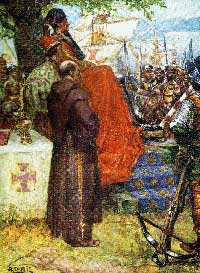 The During the 15th and 16th centuries, Portugal led the world in navigation and exploration, and they believed it was their duty to spread the Catholic religion. Portuguese missionaries receiving the ‘native chief’ at Elmira. Source: heritage-history.com
The During the 15th and 16th centuries, Portugal led the world in navigation and exploration, and they believed it was their duty to spread the Catholic religion. Portuguese missionaries receiving the ‘native chief’ at Elmira. Source: heritage-history.com
The Portuguese did not have an easy time on the east coast of Africa. They found the climate inhospitable and many died of tropical diseases. They were also constantly attacked by hostile inhabitants of the area and were unable to conquer the interior of Africa. They managed to keep control by making alliances with warring clans and promising to help them against their enemies.
The Portuguese rulers believed it was their duty to spread the Catholic religion. Missionary activity began in 1560. Both the Jesuits and Dominicans were active in converting Africans to Catholicism. They even managed to convert one of the heirs to the Mwanamutapa dynasty who gave up his right to be king and joined a convent in Santa Barbara in India.
By the early sixteenth century the Portuguese had established a string of bases in Asia, including Hormuz at the tip of the Persian Gulf; Goa on the west coast of India and the Straits of Molucca in the East Indies.
From these bases, the Portuguese could control the sea-going trade of the entire western Indian Ocean. However, Portugal was mainly a maritime power; it was not able to defeat other military powers. When larger European nations like the Dutch, English and French arrived in the area, Portuguese power and control ended, and by 1650 they only had control in ports such as Delagoa Bay, Mozambique Island and Mombasa. Mozambique (Portuguese East Africa) was only recognised as a Portuguese colony by the other European powers in 1885.
The Portuguese legacy in East Africa
- The Portuguese destroyed the Arab trade routes in the Indian Ocean between Africa, Arabia and India.
- The Portuguese replaced Arab control of the trade in ivory, gold and slaves with their own.
- They traded up the Zambezi river and interfered with the existing inland African trade. Only kingdoms that co-operated with the Portuguese benefited from this interference.
- Portuguese is still spoken in Mozambique, but the majority of the rural population speaks one of the indigenous Bantu languages.
- Only thirty per cent of the population is Christian, mostly Catholic. The majority of the population practise traditional African religions or no religion at all.
The Dutch in Southern Africa
The Dutch challenged Portuguese domination of the Indian Ocean trade in the late sixteenth century when they began trading in spices, calico and silks in the East and gold, copper, ivory and slaves in Africa. In the seventeenth and early eighteenth centuries the Netherlands became the wealthiest European trading nation, until Britain challenged them in the eighteenth and nineteenth centuries.
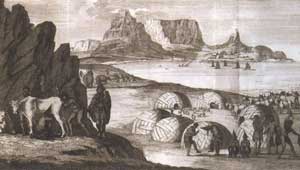 The foreground of this illustration from Bogaarts’s Historische Reizen (1711) depicts the Khoikhoi way of life. The background shows the Dutch settlement and way of life beginning to take root. Source: South African National Library.
The foreground of this illustration from Bogaarts’s Historische Reizen (1711) depicts the Khoikhoi way of life. The background shows the Dutch settlement and way of life beginning to take root. Source: South African National Library.
The Dutch East India Company (known by the Dutch abbreviation VOC) was established in 1602 to conduct Dutch trade with the East Indies. Its headquarters were in Jakarta on the island of Java. Because the journey to the East took so long, European shipping nations stopped at the Cape of Good Hope to collect fresh water and food. The Khoikhoi people at the Cape traded sheep, cattle, ivory, ostrich feathers and shells for beads, metal objects, tobacco and alcohol. Unlike the Portuguese, the Dutch did not trade guns as they did not want the Khoikhoi to use the guns against them.
In 1652, the VOC decided to establish a permanent refreshment station at the Cape. Jan van Riebeeck was appointed commander of this station. It was his responsibility to build a fort for their protection and a hospital for sick sailors. Employees of the company planted vegetables and obtained meat from the Khoikhoi so that they could supply the ships as they called in at Table Bay. French and English ships were also allowed to stop at the Cape, but they were charged very high prices.
Expansion of the Dutch settlement
Increasingly the Khoikhoi lost land and cattle to the Dutch as the settlement grew. This brought the Dutch into conflict with the powerful Cochoqua chief, Gonnema, who refused to trade with the VOC. The Company used rival Khoikhoi clans to raid the Cochoqua herds between 1673 and 1677. This is known as the Second Khoikhoi-Dutch War. The Cochoqua were defeated and lost all their cattle and sheep to the Dutch and their Khoikhoi allies. The boers then settled on their land.
Wheat and grapes for wine were grown in this area for the settlement and for export to the passing ships. The settlers were sold slaves from Madagascar, Mozambique and Indonesia to work the land.
The Trekboers
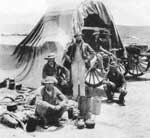 Trek Boers in the Karoo. Source: wikipedia
Trek Boers in the Karoo. Source: wikipedia
As the settlement grew, some of the farmers became hunters and cattle farmers in the interior of the Cape. They were known as ‘trekboers’ because they lived in ox-wagons and were always on the move. They were granted large pieces of land each and allowed their cattle to graze on the land until it was overgrazed and then they would move on.
In the 1680s and 1690s the VOC encouraged Dutch and French Huguenot immigration to the Cape. The new arrivals were settled in the fertile valleys of Paarl, Stellenbosch and Franschhoek. Wheat and grapes for wine were grown in this area for the settlement and for export to the passing ships. The settlers were sold slaves from Madagascar, Mozambique and Indonesia to work the land.
Khoikhoi resistance in the interior
The Khoikhoi were at a disadvantage in their struggle to resist the expansion of the Dutch settlement at the Cape. They had no guns or horses and were nearly wiped out by a series of smallpox epidemics that swept through the Cape starting in 1713. Like the Aztecs in Mexico, they had no immunity against European diseases and they died in their thousands.
The Khoikhoi found different ways to resist Dutch expansion. At first they resisted by attacking and raiding Dutch farms. In reaction, the trekboers formed themselves into military groups called ‘commandos’ and attacked the Khoikhoi in order to get back their cattle. As a result, hundreds of Khoikhoi people were killed. As soon as the commandos returned to their farms, the Khoikhoi attacked again, setting in motion a continuous cycle of attack and counter-attack.
In the end the Khoikhoi had two options. Either they could move into more remote and drier regions of the expanding colony or else they could become servants of the boers acting as trackers, herdsmen and shepherds. Some even joined boer commandos and attacked other Khoikhoi groups. The boers were not allowed to enslave the indigenous people of South Africa, so these Khoikhoi servants remained free citizens, but they were seldom paid wages. They were usually paid in food, clothing, housing, brandy and tobacco. They were sometimes allowed to keep cattle, but they lost their independence and with that much of their culture and language. In the Eastern Cape, many Khoikhoi people were absorbed into Xhosa society.
The impact of Dutch rule at the Cape
- The arrival of Dutch settlers marked the permanent settlement of Europeans in Southern Africa.
- Dutch laws, customs and attitudes towards race were brought to South Africa and Dutch people became the ruling class until the Cape was taken over by the British in 1806.
- The Dutch did not actively encourage the Khoikhoi or slaves to become Christians as this would imply they were equal.
- The process of land dispossession by indigenous people in South Africa began soon after the arrival of the Dutch and lasted until 1994.
- Racial mixing occurred at the Cape, but it was never openly accepted like it was in colonies such as Brazil and Mexico. A few legal marriages did occur between different races, but most of the relationships across race lines were between European men and their female slaves or Khoikhoi servants. The children of these relationships formed part of what is known today as the Cape Coloured community.
- Freed slaves were also included into the Cape Coloured community. Many of the freed slaves were Muslims and maintained their Malay cultural and religious traditions.
- The Dutch language became simplified as it was spoken by the multi-cultural community that existed at the Cape. Portuguese, Malay and Khoikhoi words were included in the common language now spoken, which became known as ‘Afrikaans’.
European control of India Britain takes control of India
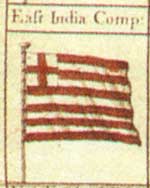 British East India Company flag. Source: wikipedia
British East India Company flag. Source: wikipedia
In May 1498 Vasco da Gama sailed into the harbour of Calicut (now Kozhikode) on the Malabar Coast of India. The Portuguese dominated the trade routes on the coast of India during the sixteenth century. The Dutch forced the Portuguese out of India in the seventeenth century. The Dutch East India Company was soon followed by the English East India Company. Both companies began by trading in spices, but later shifted to textiles. They operated mostly on the southern and eastern coasts of India and in the Bengal region. The French also joined trade in India in about 1675.
The English East India Company founded trading stations known as factories at Surat (1612) and Madras (1639) (now Chennai) under the authority of the Mogul Empire. Rapid growth followed, and in 1690 the company set up a new factory further up the Hugli river, on a site that became Calcutta (now Kolkata). By 1700 the company had extended its trading activities in Bengal and used this as a reason to involve itself in Indian politics.
As the French and British were fighting over the control of India’s trade, the Mogul Empire was experiencing serious problems and regional kingdoms were becoming more powerful. The emperor, Aurangzeb, was a harsh ruler who did not tolerate the Hindu population and often destroyed their temples. He tried to force Indians to become Muslims against their will. As a result of this he was not a popular ruler. Soon after his death in 1707, the empire began to disintegrate.
The French and British took advantage of the weakness of the Mogul empire. They offered military support to the regional rulers who were undermining the empire. The British and the French kept increasing their own political or territorial power while pretending to support a specific local or regional ruler. By 1750 the French managed to place themselves in a powerful position in southern India, but a year later British troops took the French south-eastern stronghold by force.
In Bengal, the English East India Company strengthened Fort William in Calcutta (now Kolkata) to defend itself against possible attacks by the French. This area was part of the Mogul Empire and its emperor attacked Calcutta in 1756. After this attack the British governor moved north from Madras and secretly conspired with the commander of his enemy’s army. The Mogul emperor was defeated at Plassey by the Company troops under the command of Robert Clive in 1757.
The French attempted to regain their position in India but were forced to give up Pondicherry in 1760. In 1774 the British again defeated local rulers and firmly established British control over the Bengal region.
Resistance in India
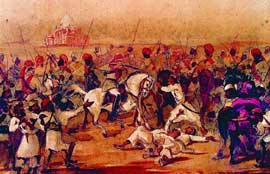 Batlle in the Subzee Mundee, a watercolour of the Sepoy Rebellion of 1857by British artist G F Atkinson. Source: historyfiles.co.uk
Batlle in the Subzee Mundee, a watercolour of the Sepoy Rebellion of 1857by British artist G F Atkinson. Source: historyfiles.co.uk
Between 1800 and 1857 the English East India Company extended British control by fighting wars against Afghanistan, Burma, Nepal, the Punjab and Kashmir. They made use of both Indian and British soldiers to gain more land.
The Indian population did not like British rule. This led to the Sepoy Rebellion of 1857, in which Indian soldiers (called sepoys) staged an armed uprising. The rebellion failed because it lacked good leaders and did not have enough support. The uprising did not upset British rule, but many lives were lost during this rebellion. The British then focused on governing efficiently while including some traditional elements of Indian society. After 1858 India was no longer controlled by the East India Company and was brought directly under British rule instead.
Britain did not control the whole of India at this time. Many princes signed treaties with the British and agreed to co-operate with the British. In other areas the British appointed Indians as princes and put them in charge. In this way Britain ruled the so-called Indian States indirectly. Queen Victoria of Britain appointed a viceroy to rule India.
The impact of British rule on India
- Colonial empires became rich and powerful as their empires grew in size. However, colonies were expensive to run, especially if wars were involved. Wars were fought between rival empires who wanted the same land or to defeat rebellious indigenous inhabitants.
- Europe, in particular Britain, was able to industrialise because of raw materials obtained from colonies and because colonies provided markets for manufactured goods. Slavery did not start because of colonialism; slavery has always existed. However, European powers were able to exploit their colonies and increase their wealth by using slave labour or very cheap indigenous labour.
- Colonialism did not cause racism, but it helped to reinforce the belief that Europeans were the dominant race and therefore superior and that other races were subordinate and therefore inferior.
- On the other hand, colonialism provided opportunities for people of different races, religions and cultures to meet, live and work together. The result of this has been an exchange of ideas, technology and traditions.
- The spread of Christianity throughout the world was made possible by missionary activities. This was assisted by the expansion of European colonial empires.
- Church and state worked together to change the indigenous belief systems of the people they ruled. Colonial expansion also brought Christianity into conflict with Islam as European powers challenged Muslim rulers and traders.
European domination of the world
The expansion of European trade resulted in the colonisation of five continents over a period of five centuries. Using military force, each of the European colonial powers dominated world trade at different times. When one colonial power became weak, another challenged it and replaced it as the dominant power.
What was the effect of colonialism?
- Britain dominated trade in India after the collapse of the Mogul empire.
- The British maintained political control through military force.
- The British ruled India by controlling the regional rulers.
- The British built a railway system throughout India and introduced a telegraph and telephone system.
- Only two per cent of the Indian population can speak English. It is the language used by educated businessmen and politicians. The official language of India is Hindi but there are more than a thousand languages spoken in India today.
- India is the largest democracy in the world today. Although they did not rule democratically, the British did leave this legacy to the country when they granted it independence in 1947.